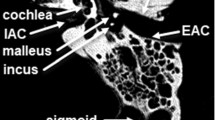Abstract
Purpose
The accuracy achievable when utilizing image guidance depends to a large extent on the accuracy with which the patient can be registered to preoperative image data. This work proposes a method for the registration of the temporal bone based on surface matching and investigates the achievable accuracy of the technique.
Methods
Fourteen human temporal bones were utilized for evaluation; incisions were made, fiducial screws were implanted to act as a ground truth, and imaging was performed. The positions of the fiducials and surface of the mastoid were extracted from image data and reference positions defined at the round window and the mastoid surface. The surface of the bone was then digitized using a tracked pointer within the region exposed by the incisions and the physical and image point clouds registered, with the result compared to the fiducial-based registration.
Results
Results of one case were excluded due to a problem with the ground truth registration. In the remaining cases an accuracy of \(0.16\pm 0.09\) and \(0.23\pm 0.1\) mm was observed relative to the ground truth at the surface of the mastoid and round window, respectively.
Conclusions
A technique for the registration of the temporal bone was proposed, based on surface matching after exposure of the mastoid surface, and evaluated on human temporal bone specimens. The results reveal that high-accuracy patient-to-image registration is possible without the use of fiducial screws.





Similar content being viewed by others
References
Gerber N, Gavaghan K, Bell B, Williamson T, Weisstanner C, Caversaccio M, Weber S (2013) High accuracy patient-to-image registration for the facilitation of image guided robotic microsurgery on the head. IEEE Trans Biomed Eng 60(4):960–968
Labadie RF, Davis BM, Fitzpatrick JM (2005) Image-guided surgery: what is the accuracy? Curr Opin Otolaryngol Head Neck Surg 13(1):27–31
Maurer CR, Gaston RP, Hill DLG, Gleeson MJ, Taylor MG, Fenlon MR, Edwards PJ, Hawkes DJ (1999) AcouStick: A Tracked A-Mode Ultrasonography System for Registration in Image-Guided Surgery. In: Medical Image Computing and Computer-Assisted Intervention—MICCAI’99, pp 953–962
Amstutz C, Caversaccio M, Kowal J, Bächler R, Nolte L-P, Häusler R, Styner M (2003) A-mode ultrasound-based registration in computer-aided surgery of the skull. Arch Otolaryngol Head Neck Surg 129(12):1310–1316
Marmulla R, Lüth T, Mühling J, Hassfeld S (2004) Automated laser registration in image-guided surgery: evaluation of the correlation between laser scan resolution and navigation accuracy. Int J Oral Maxillofac Surg 33(7):642–648
Raabe A, Krishnan R, Wolff R, Hermann E, Zimmermann M, Seifert V, Kelly PJ, Adler JR, Oyelese AA, Barnett GH (2002) Laser surface scanning for patient registration in intracranial image-guided surgery. Neurosurgery 50(4):797–803
Marmulla R, Mühling J, Wirtz CR, Hassfeld S (2004) High-resolution laser surface scanning for patient registration in cranial computer-assisted surgery. Minim Invasive Neurosurg 47(2):72–78
Glozman D, Shoham M, Fischer a (2001) A surface-matching technique for robot-assisted registration. Comput Aided Surg 6(5):259–269
Matsumoto N, Hong J, Hashizume M, Komune S (2009) A minimally invasive registration method using surface template-assisted marker positioning (STAMP) for image-guided otologic surgery. Otolaryngol Head Neck Surg 140(1):96–102
Matsumoto N, Oka M, Cho B, Hong J, Jinnouchi M, Ouchida R, Hashizume M, Komune S (2012) Cochlear implantation assisted by noninvasive image guidance. Otol Neurotol 33(8):1333–1338
Schipper J, Aschendorff A, Arapakis I, Klenzner T, Teszler CB, Ridder GJ, Laszig R (2004) Navigation as a quality management tool in cochlear implant surgery. J Laryngol Otol 118(10):764–770
Thiel W (1992) The preservation of the whole corpse with natural color. [Die Konservierung ganzer Leichen in natürlichen Farben.]. Ann Anat 174:185–195
Gerber N, Bell B, Gavaghan K, Weisstanner C, Caversaccio M, Weber S (2014) Surgical planning tool for robotically assisted hearing aid implantation. Int J Comput Assist Radiol Surg 9(1):11–20
Lorensen WE, Cline HE (1987) Marching cubes: a high resolution 3D surface construction algorithm. Comput Graph ACM 21(4):163–169
Veldpaus FE, Woltring HJ, Dortmans LJ (1988) A least-squares algorithm for the equiform transformation from spatial marker co-ordinates. J Biomech 21(1):45–54
Geiger A, Lenz P, Urtasun R (2012) Are we ready for autonomous driving? The KITTI vision benchmark suite. In: Conference on computer vision and pattern recognition (CVPR)
Brun B, Williamson T, Caversaccio M, Weber S (2013) Validation of custom active markers for use with a high accuracy tracking system. In: Wissenschaftlicher Beitrag für die 12. CURAC Jahrestagung 2013, pp 126–129
Zhou C, Williamson T, Caversaccio M, Weber S (2015) Towards high accuracy surface matching for registration of the temporal bone. In: Wissenschaftlicher Beitrag für die 14. CURAC Jahrestagung 2015, pp 61–66
Acknowledgments
This work was completed as part of the Nano-Tera initiative; the work was scientifically evaluated by the Swiss National Science Foundation, financed by the Swiss Confederation and funded by Nano-Tera.ch. The authors would like to acknowledge the Institute of Anatomy at the University of Bern for providing the temporal bone specimens. This work was also supported by National Natural Science Foundation of China (No.61190124, 61190120).
Author information
Authors and Affiliations
Corresponding authors
Ethics declarations
Conflict of interest
The authors declare that they have no conflict of interest.
Ethical approval
All procedures performed in studies involving human participants were in accordance with the ethical standards of the institutional and/or national research committee and with the 1964 Declaration of Helsinki and its later amendments or comparable ethical standards. This article does not contain any studies with animals performed by any of the authors.
Informed consent
Informed consent was obtained from all individual participants included in the study.
Rights and permissions
About this article
Cite this article
Zhou, C., Anschuetz, L., Weder, S. et al. Surface matching for high-accuracy registration of the lateral skull base. Int J CARS 11, 2097–2103 (2016). https://doi.org/10.1007/s11548-016-1394-3
Received:
Accepted:
Published:
Issue Date:
DOI: https://doi.org/10.1007/s11548-016-1394-3




